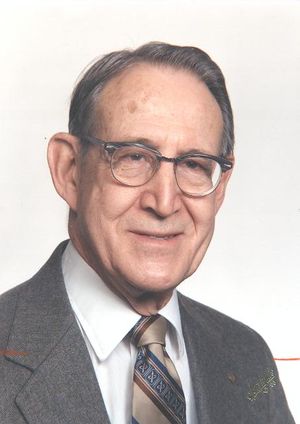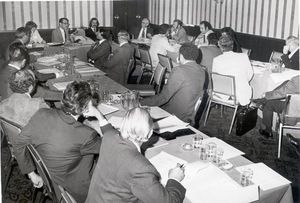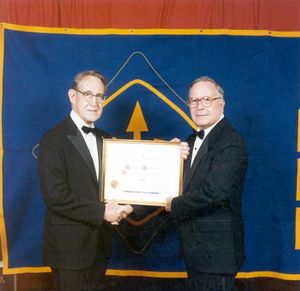Harold Chestnut: Difference between revisions
No edit summary |
Mahellrigel (talk | contribs) mNo edit summary |
||
| (14 intermediate revisions by 5 users not shown) | |||
| Line 1: | Line 1: | ||
{{Biography | |||
|Image=Harold Chestnut 2272.jpg | |||
|Birthdate=1917 | |||
|Birthplace=Albany, NY, USA | |||
|Death date=2001/08/29 | |||
|Associated organizations=[[General Electric (GE)]] | |||
|Fields of study=Control systems | |||
|Awards=IEEE Centennial Medal; AACC Bellman Heritage Award | |||
|Abstract=worked in the control field at the General Electric Company, and he helped to form the International Federation of Automatic Control (IFAC). | |||
|Organization=IEEE | |||
|StartYear=1973 | |||
}} | |||
[[Image:Chestnut at Wld Env and Res Counc 1168.jpg|thumb|right|IEEE President Harold Chestnut at founding meeting of World Environment and Resources Council, September 1973]] | |||
[[Image: | [[Image:Chestnut Emberson award 0693.jpg|thumb|right|Chestnut receiving the IEEE Richard M. Emberson Award]] | ||
Harold Chestnut (IRE Senior Member, 1957) was born in New York on 25 November 1917. He earned B.S.E.E. and M.S.E.E. degrees in electrical engineering from the Massachusetts Institute of Technology (MIT) in 1939 and 1940, respectively. He received Honorary Doctorates in engineering from Case Institute of Technology in 1966 and Villanova University in 1972. | |||
Chestnut began a life-long career in the control field with the [[General Electric (GE)|General Electric Company]] in 1940. His early control work concerned stability issues in electric power systems. During the Second World War he was both a student and instructor in GE's well-known Advanced Engineering Program. During the Second World War he moved into the aeronautics and ordinance divisions of the company and remained there until 1956. In 1951 he co-authored ''Servomechanisms and Regulating Systems Design, Vol. 1'' with R. W. Mayer, which was the leading text in the field for many years. He later wrote Volume 2 of that book, as well as ''System Engineering Tools'', and ''System Engineering Methods''. | |||
Chestnut was active in the formation of the International Federation of Automatic Control (IFAC), which grew out of discussions started in 1956 among representatives from West Germany, the USSR, France, the United Kingdom, Poland and the USA. He served as IFAC's first president from 1957 through 1959 in a cold-war compromise that gave the USA the first president and the USSR the first International Congress in Moscow in 1960. | |||
Chestnut continued with the General Electric Company until retirement in 1983. Major assignments included serving as manager of the Systems Engineering and Analysis Branch of the Advanced Technology Laboratory, working on a wide variety of technical problems including reliability issues in rapid transit and the Apollo mission to the moon. Later in his career he returned to the field of electric power and this time the focus was power systems automation. | |||
Following retirement, he concentrated on one of his long time passions in the control field; the potential for control concepts to provide insight into problems of international stability. His dedication to the use of control concepts in societal problems arose from his success in working with wary representatives from many countries to set up IFAC and with proud representatives from various US engineering societies to set up the AACC. Two years before his retirement, Dr. Chestnut received the prestigious Honda Prize for ecotechnology and with it a substantial financial award. After retirement he used this fund to create the "SWIIS Foundation", a private foundation devoted to identifying and implementing "supplemental ways to improve international stability". During the 1980s and 1990s, he devoted the last productive years of his life to this effort. | |||
Before 1963, he chaired the [[AIEE History 1884-1963|AIEE]] Technical Committees on Automatic Control and on [[IEEE Systems, Man, and Cybernetics Society History|Systems, Man, and Cybernetics]]. He later had several other leadership roles in the IEEE, culminating in his term as [[Presidents of the Institute of Electrical and Electronics Engineers (IEEE)|President of the IEEE]] in 1973. He was a [[IEEE Fellow Grade History|Fellow]] of the AIEE, ISA, and AAAS. He was elected to the US National Academy of Engineering in 1974 and selected as a Case Centennial Scholar in 1980. He received the IEEE Centennial Medal in 1984 and the AACC Bellman Heritage Award in 1985. | |||
Harold Chestnut is remembered as a quiet, but persistent man. Once he determined something ought to be done, he worked until he found a way to achieve his goal. He viewed life as one large control system that needed to be nudged from time to time to keep it running smoothly and on course. Chestnut and his wife, Erma Ruth Callaway, were married for fifty-seven years and had three sons. He was a devoted family man who enjoyed hiking and sailing with his family, especially at their cottage on Schroon Lake in the Adirondacks. | |||
On 29 August 2001, Harold Chestnut died at the age of 83 in Schenectady, New York, the town in which he spent essentially all of his long and productive life. | |||
== Further Reading == | |||
[[Archives:Conversations with the Elders - Harold Chestnut|Conversations with the Elders - Harold Chestnut]] - An interview with Chesnut by the Georgia Institute of Technology | |||
[[Category:People_and_organizations]] [[Category:Engineers]] | {{DEFAULTSORT:Chestnut}} | ||
[[Category:Automation]] | |||
[[Category:Control_systems]] | |||
[[Category:People_and_organizations]] | |||
[[Category:Engineers]] | |||
Latest revision as of 21:41, 18 July 2018
- Birthdate
- 1917
- Birthplace
- Albany, NY, USA
- Death date
- 2001/08/29
- Associated organizations
- General Electric (GE)
- Fields of study
- Control systems
- Awards
- IEEE Centennial Medal, AACC Bellman Heritage Award
1973
Harold Chestnut, IEEE President, 1973, worked in the control field at the General Electric Company, and he helped to form the International Federation of Automatic Control (IFAC).
Biography
Harold Chestnut (IRE Senior Member, 1957) was born in New York on 25 November 1917. He earned B.S.E.E. and M.S.E.E. degrees in electrical engineering from the Massachusetts Institute of Technology (MIT) in 1939 and 1940, respectively. He received Honorary Doctorates in engineering from Case Institute of Technology in 1966 and Villanova University in 1972.
Chestnut began a life-long career in the control field with the General Electric Company in 1940. His early control work concerned stability issues in electric power systems. During the Second World War he was both a student and instructor in GE's well-known Advanced Engineering Program. During the Second World War he moved into the aeronautics and ordinance divisions of the company and remained there until 1956. In 1951 he co-authored Servomechanisms and Regulating Systems Design, Vol. 1 with R. W. Mayer, which was the leading text in the field for many years. He later wrote Volume 2 of that book, as well as System Engineering Tools, and System Engineering Methods.
Chestnut was active in the formation of the International Federation of Automatic Control (IFAC), which grew out of discussions started in 1956 among representatives from West Germany, the USSR, France, the United Kingdom, Poland and the USA. He served as IFAC's first president from 1957 through 1959 in a cold-war compromise that gave the USA the first president and the USSR the first International Congress in Moscow in 1960.
Chestnut continued with the General Electric Company until retirement in 1983. Major assignments included serving as manager of the Systems Engineering and Analysis Branch of the Advanced Technology Laboratory, working on a wide variety of technical problems including reliability issues in rapid transit and the Apollo mission to the moon. Later in his career he returned to the field of electric power and this time the focus was power systems automation.
Following retirement, he concentrated on one of his long time passions in the control field; the potential for control concepts to provide insight into problems of international stability. His dedication to the use of control concepts in societal problems arose from his success in working with wary representatives from many countries to set up IFAC and with proud representatives from various US engineering societies to set up the AACC. Two years before his retirement, Dr. Chestnut received the prestigious Honda Prize for ecotechnology and with it a substantial financial award. After retirement he used this fund to create the "SWIIS Foundation", a private foundation devoted to identifying and implementing "supplemental ways to improve international stability". During the 1980s and 1990s, he devoted the last productive years of his life to this effort.
Before 1963, he chaired the AIEE Technical Committees on Automatic Control and on Systems, Man, and Cybernetics. He later had several other leadership roles in the IEEE, culminating in his term as President of the IEEE in 1973. He was a Fellow of the AIEE, ISA, and AAAS. He was elected to the US National Academy of Engineering in 1974 and selected as a Case Centennial Scholar in 1980. He received the IEEE Centennial Medal in 1984 and the AACC Bellman Heritage Award in 1985.
Harold Chestnut is remembered as a quiet, but persistent man. Once he determined something ought to be done, he worked until he found a way to achieve his goal. He viewed life as one large control system that needed to be nudged from time to time to keep it running smoothly and on course. Chestnut and his wife, Erma Ruth Callaway, were married for fifty-seven years and had three sons. He was a devoted family man who enjoyed hiking and sailing with his family, especially at their cottage on Schroon Lake in the Adirondacks.
On 29 August 2001, Harold Chestnut died at the age of 83 in Schenectady, New York, the town in which he spent essentially all of his long and productive life.
Further Reading
Conversations with the Elders - Harold Chestnut - An interview with Chesnut by the Georgia Institute of Technology


